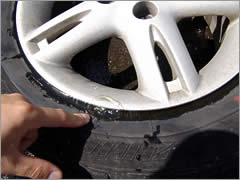Prolong Life Of Tire - Tire Pressure And Rotating Tire - Vol.204
A general consensus among the automotive community is that you should change out the tires on your vehicle once every 40,000 miles. Driving on tires that are completely worn out or bald can be inherently dangerous to both you and other drivers on the road. Bald tires will not give you proper traction on slippery roads and have the potential of causing a blowout that could result in a serious accident or perhaps even fatal consequences.
Aside from the engine, tires are probably one of the most important parts of your vehicle. For the budget conscience trying to forestall the hefty price of new tires, there are two prominent ways to extend the life of tires and continue using the same tires past the 40,000 mark?safely. It should be noted that these two methods must be used throughout the life of the tire to be effective. Trying to use the following two methods towards the end of your tire life will be unlikely, if at all, to helpful at forestalling the replacement of already worn down tires. Follow maintenance guidelines and make sure you follow these recommendations to regularly monitor tire pressure and schedule tire rotations to prolong the life of your tires.

Regularly Monitor Tire Pressure
Purchase a gauge from a gas station or auto parts store and whenever you stop at a gas station to fill up for gas, check the pressure in each one of your tires. These hand held gauges are often quite affordable and easy to use. By keeping all four of your tires at or close to factory recommended pounds per square inch (PSI), you will reduce rubber drag on the road, prolong the life of your tires, and increase fuel efficiency on your vehicle.
If your vehicle is driving down the road with underinflated tires, the rubber that is not properly inflated is dragging against the road creating friction. This friction results in heat that works to break down the rubber on the tire and cause your tires to wear out faster. If tires get too hot from this increase in friction, your tired could pop while you are driving resulting in what is known as a blowout.
To find out the recommended PSI for your vehicles tires, just look at the tire. The factory recommendations for that tire should be printed directly onto the tire so that you don't have to pull out any vehicle manual and look it up every time you forget. If your vehicle does need air, be careful not to overinflate your tires as this could also result in either a blowout or a concentration in tire wear on the center of the tire instead of balanced out of the entire tire.
Schedule Tire Rotations
Different sets of tires can wear down at different periods of a certain part of the tire can receive a majority of the wear. This is particularly common if you drive a front wheel drive vehicle that puts around 65% of the weight on the front two tires and results in quicker tire replacement rates on the front set of tires than the back two tires.
A reasonable recommendation is to rotate your tires about once every 10,000 miles. These rotations can sometimes be performed at no cost to you through the tire company that you purchase your set of tires at. Taking your vehicle to a tire specialist to perform this rotation can also be a better option than attempting this task yourself as they will be able to determine what rotation pattern would be best for your vehicle. There are three primary rotation patterns used when rotating tires that you specialist can discuss with you to find the best solution.